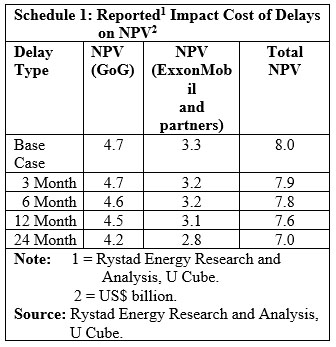In today’s column I continue my summary appraisal of the adverse impacts of the 2020 general crisis, as I have defined this phenomenon, on Guyana’s infant oil and gas sector. Thus far, I have treated with the adverse impacts on the price and quantity of Guyana’s crude oil sales. To recall, the new oil sector had been modeled and published by the Authorities in Q4, 2019 with a 2020 output of 102,000 barrels of crude oil per day and a price of US 64 per barrel. The lead contractor, ExxonMobil and partners, had by then already projected output at 120,000 barrels per day.
Based on calculations of projected 2020 Government of Guyana (GoG) profit share provided by the Department of Energy (DoE) – five million barrels of crude oil versus the reported profit share of only four million barrels – there is an indication of an output shortfall in the region of 20%. Similarly, based on calculations of projected royalties – US$18 million for 2020 – the 2% rate on gross production would yield a gross value of US$0.9 billion for 2020. Both these calculations are very rough. They do, however, remind us of the gap in the provision of timely data on the sector’s performance by the public and private authorities.
The valuations given in the above paragraph reflect combined price and quantity effects. With all of Guyana’s sales taking place in the world market, prices received are available in real time. I remain convinced the substantial decline in global crude oil prices is reflected in delayed publication of Guyana’s oil sales.
Impeded performance
Four factors were highlighted last week as being principally responsible for the 2020 production delays identified in Guyana. First, start-up mechanical problems (compression related); second, inability to undertake timely repairs and maintenance due to pandemic-related setbacks and delays; third, pandemic-related considerations also impeded the deployment of both overseas and local workers to Guyana’s offshore production facilities; and fourth, regulatory hold- ups, especially in regard to permission for the Payara project go ahead. The last was also affected by the electoral and political crisis following national elections.
Indeed, such considerations led Rystad Energy to publish a report on the “impact costs of delays” in the execution of planned production in Guyana’s infant oil and gas sector. I had evaluated this report in my column of September, 27 2020; and I reproduce in Schedule 1 data showing Rystad’s results. The Schedule clearly reveals a clear-cut outcome; that is, the net present value (NPV), yielded by available projects declines as the time period of the delay extends. Delays are clearly likely to be progressively costly.
Parenthetically, it is worth noting that the indicated shares of NPV going to the GoG and contractor (ExxonMobil and partners) in the Rystad Energy’s report confirms to their separate estimation of GoG take at 60%.
Measuring Impacts
For the average reader, the list of micro and macroeconomic impacts of the 2020 crisis that should be investigated and quantified is quite formidable. I had, therefore, in earlier columns sought to find for the broad public’s benefit, a proxy/summary indicator that best captured the totality of these economic impacts. That proxy indicator or measure is the GDP at constant prices.
I have advanced the proposition that the rate of growth of Guyana’s GDP at constant prices is a summary measure of economic impacts positive and negative. Consequently, I have used time-based differences in estimated growth rates of Guyana’s GDP, starting with the Authorities pre-crisis estimate and those that followed subsequently as the crisis unfolded during 2020, as a measure of the overall economic value of the reverses or setbacks to the economy. Although the estimates provided institution varied, all estimates were revised downwards the later in the year they were made.
Readers should observe the World Bank’s World Economic Outlook (WEO) provides a simple and effective description of what the GDP represents. As the WEO states: “it is the most commonly used single measure of a country’s (Guyana) overall economic activity. It represents the total value at constant prices of final goods and services produced within a country (Guyana) during a specified period of time (2020)”. The performance of Guyana’s oil and gas sector is therefore, captured in its GDP measurements. Consequently, as estimates of this measure are updated when 2020 advances, these estimates ought to capture economic impacts of the 2020 general crisis on the hydrocarbons sector in the performance of Guyana’s GDP.
Updated forecasts reveal quite dramatic results. The original 2020 forecast made by the Authorities back in Q4, 2019 was based on the expectation of:
1) continued investment in the oil and gas sector in 2020;
2) an output of 102,000 barrels of oil per day on average;
3) oil sold at US$64 per barrel.
This forecast was made jointly by the Guyana Authorities and the IMF and announced in Q4, 2019. It revealed a whopping projected growth rate of 86% for 2020. This rate was easily, the fastest projected rate of growth for any country in the world, for 2020!
Conclusion
Next week, I’ll present a Schedule summarising these data as I wrap-up this presentation on the use of real GDP behaviour as a proxy indicator for the economic impacts of the 2020 general crisis on Guyana’s infant oil and gas sector.







